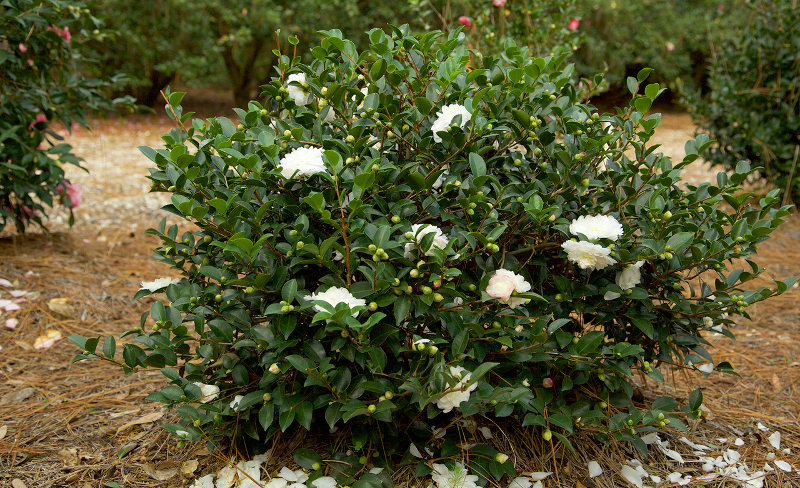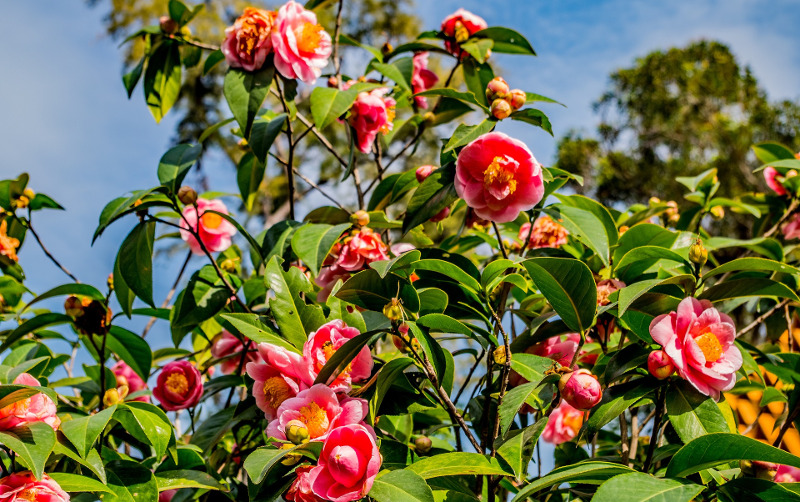For the camellia of your dreams, with lush evergreen foliage showing off blowsy blooms, you can’t skip fertilizing. Camellias need a specific type of fertilizer that creates the ph level in the soil that promotes optimal growth. You want to start in spring, typically with a slow-release fertilizer made for “acid-loving” plants.

Potted camellias can benefit from repeat applications of liquid fertilizer throughout the growing season and/or cottonseed meal for an organic nitrogen source. Organic fertilizers cannot burn your plants as synthetic ones can. Like watering, camellias prefer a slow, steady drip of fertilizer rather than irregular doses.
If the foliage looks sparse or pale, you know your plant is missing basic growth nutrients. If it is yellow, also called chlorotic, it is usually a lack of acidity in the soil.
These suggestions apply for newly planted or established camellias in your garden.
Best Time to Fertilize Camellia
With so many types of different fertilizing methods available, you may be wondering when is the best time to fertilize your camellia? Early or mid-spring is the best time to start – after flower drop for winter-flowering types – usually with a balanced slow-release type fertilizer that is formulated for plants that prefer acidic soil conditions.
You can repeat each month but take care to follow the product guidelines. Overfertilizing can cause burnt-looking leaf edges, large amounts of leaf drop, or mottled brown spots on the leaves.
Avid growers break down their schedule into more nitrogen in spring, nitrogen/phosphate mid-summer, and finally potassium in late summer.
Another option for potted camellias would be to follow up your acidic slow-release fertilizer with dilute applications of a balanced all-purpose liquid fertilizer, which is more readily available to the plants than the slow-release type.

Best Fertilizer for Camellia
The easiest route is to find a balanced fertilizer made for acid-loving plants including azaleas, rhododendrons and camellias. The nutrient mix will have consistent levels of nitrogen, phosphorus and potassium, such as 8-8-8 or 10-10-10.
As mentioned above, enthusiasts find or make mixes with high nitrogen for spring, a blend of moderate nitrogen/phosphorus for mid-season, and a potassium booster for late summer. Sometimes cottonseed meal is used monthly as a gentle nitrogen feed, especially for camellias in containers.
Because camellias are sensitive to over fertilizing, we recommend organic formulations or ingredients, and always follow the feeding recommendations for the product.
Camellia Fertilizing Tips
- Camellias like moderate, steady feeding throughout the growing season.
- They are sensitive to over- or under-feeding
- The best fertilizers are formulated for acid-loving plants, and ideally, organic
- Water before feeding, and avoid feeding in the heat of the day or during heat waves.
Warnings
-Always wear protective gloves and a face mask when handling chemical fertilizers.
-Closely follow all directions and storage guidelines that are on the fertilizer label.
 |
Author Erica Browne Grivas - Published 11-16-2021 |
